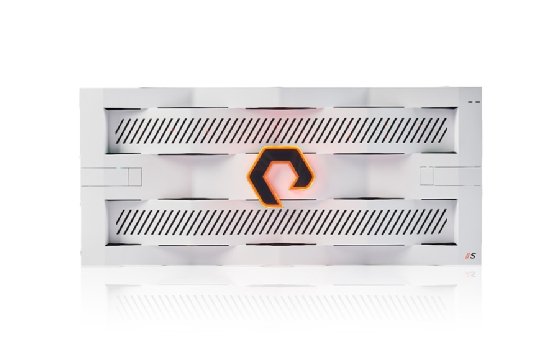
Getty Images
Pure Storage FlashBlade//S increases performance, flexibility
The new Pure Storage FlashBlade//S expands the file and object storage array into a family with more options and more use cases.
Pure Storage users now have the option to more easily mix and match modular flash storage and compute to increase speed and performance.
Released today at the Pure Accelerate Techfest22 in Los Angeles, the FlashBlade//S is a new, modular unified file and object storage array. Unlike the previous FlashBlade, the S has moved from a single product into a family of products that offers various blade options for different uses. The vendor has also disaggregated the main components of compute and storage, allowing for more scale-out options.
Released in 2017, FlashBlade saw various iterations to improve things such as density, but there have been no major upgrades to the array, according to Chris Evans, an analyst at Architecting IT. The S is a completely redesigned architecture.
"They've effectively created what is version two of FlashBlade, which has taken some of the initial design restrictions away," Evans said. "What [Pure Storage] has built is a more mature product."
The initial FlashBlade was inflexible in that users couldn't upgrade one component without upgrading all of it, he added.
Modernizing the modular system
Pure Storage uses DirectFlash Modules (DFMs) instead of standard SSDs for storage, for what the company claims is more efficient flash usage and better performance.
The FlashBlade//S not only disaggregates storage and compute, but it also supports standard DFMs, according to Robert Lee, CTO of Pure Storage. This can lower the need for additional arrays as it allows for denser flash per blade without giving up performance, he said.
The release of Evergreen Flex will lead to other benefits down the road. Eventually, customers will be able to swap DFMs from an unused Pure FlashArray into a FlashBlade, Evans said.
"[As a customer, you can] say, 'Let's pull those storage modules out of this FlashArray over here, reformat them and put them into the FlashBlade,' because you don't want to buy more hardware," Evans said.
There might be limitations in the initial instance with mixing and matching, but eventually customers will be able to repurpose older storage, he said.

The compatibility of different DFMs between FlashArray and FlashBlade at launch isn't yet supported, according to Pure Storage. However, in the future, decoupling of storage and compute in the FlashBlade allows for more mixing and matching, and changing over time, according to Justin Warren, an analyst at PivotNine. The flexibility extends from a single array to across a fleet.
"We've seen this with Pure Fusion and the way that it's being orchestrated to Pure One," he said. "It's less about individual arrays now and much more into fleet management."
Pure Storage has taken FlashBlade, which was set aside from the rest of its line, and merged it back in, Warren said. This links back to the company's strategy, such as its Evergreen storage-as-a-service pricing mode, and removal of siloed parts to have all components working together.
More flexible storage
Previously, customers could only scale out both storage and compute by adding new blades, Pure Storage's Lee said. The new array uses Purity software and all quad-level cell (QLC) flash memory, but there are more hardware options. The previous FlashBlade had compute and storage soldered together, but that has been decoupled in the new version.
There are now two blade versions -- S200 and S500 -- with the higher number having more powerful CPUs, Lee said. If customers need more performance, they can swap out the S200 for the S500. This also opens up more use cases.
The new blades bring several benefits to the redesign, Evans said. The old blades can be thought of as system on a chip (SoC) storage controllers -- it had its NAND, a field-programmable gate array and a bit of DRAM on it. If something went wrong, users replaced the whole thing.
"They've basically replaced the blade with a processor that is no longer an SoC. It's actually a socket," he said. This allows users to change out storage to increase density or use existing DFMs, and supports future upgrades to faster sockets as they become available.
While there are benefits to this approach, the new FlashBlade is not fully fungible, PivotNine's Warren said. Users can't just plug anything into the array to make it work for specific use cases; that is not how physical hardware and software work.
Growth and competition
The FlashBlade//S fits in a 5U chassis, up from the previous unit's 4U, and has decreased the total amount of blades from 15 to 10, Lee said. The new blades are wider to support more powerful Intel CPUs. The width also allows for four Pure Storage DFMs to fit into each blade.
Pure Storage offers the two blade options and DFMs in either 24 or 48 TBs of all-flash storage with a minimum of seven blades to start. This can be seen as a potential downside, Architecting IT's Evans said. That is a higher number to start with, but scale-out customers will probably need a higher starting point.
Pure Storage offers scale-up in its FlashArray line and scale-out with FlashBlade. This, along with the new flexibility of FlashBlade, helps the company target several use cases such as analytics, AI, technical computing, life sciences, backup and data protection.
The new FlashBlade will stack up against the incumbents in flash storage, including NetApp, IBM, Dell and HPE, according to Warren. While AI and machine learning workloads grab headlines, they are still quite niche. This new system will compete against mainstream workloads.
Adam Armstrong is a TechTarget news writer covering file and block storage hardware and private clouds. He previously worked at StorageReview.com.





